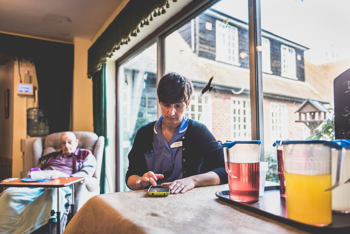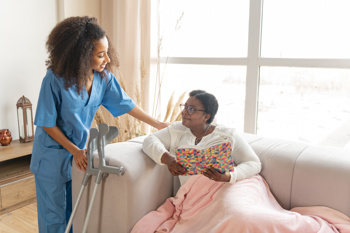
The Purpose of Incident Reporting
Reporting incidents is about more than ticking boxes, it’s about ensuring accountability, learning from events and most importantly, safeguarding people receiving care. Whether it’s a care recipient fall, a medication error or an equipment malfunction, incidents must always be documented clearly, consistently and in a way that supports follow-up actions.
This includes meeting expectations from regulators like the CQC in England and legal obligations under frameworks such as RIDDOR (Reporting of Injuries, Diseases and Dangerous Occurrences Regulations), ensuring the safety of care recipients, ensuring staff actions are documented and for continuous improvement, e.g. to fuel training, policy updates and procedural changes. However, for many care services, the systems in place don’t support this well.

Problems with Current Incident Report Forms
Many care providers use generic templates, PDFs or legacy systems that offer little room for customisation. This becomes a serious issue for care groups delivering multiple types of support across different locations, each with its own clinical, legal or regional requirements. For example, one service may need a childcare incident report form, another may require a tailored incident report form aged care template that reflects local safeguarding policies. Yet most systems offer a ‘one size fits all’ solution which is inadequate.
It’s not unusual for providers to decline incident reporting software altogether due to it not allowing custom fields based on care types (e.g. dementia, nursing, home care), different data capture for regional regulators or editable templates by clinical leads or compliance officers. This lack of flexibility not only creates reporting gaps but also reduces frontline engagement. This can cause frustration amongst staff who may end up skipping completing reports. This results in risk exposure, inconsistent care and poor outcomes.
Benefits of Smart Reporting Tools
Implementing smart and customisable incident reporting systems in health care can significantly improve safety, compliance and operational efficiency across care settings. In modern accident and incident reporting in care homes, flexibility and precision are no longer optional and should be treated as essential.
Digital solutions, like Access Care Compliance, can allow teams to generate real-time, audit-ready data that supports swift decision-making and evidenced regulatory compliance. For example, instead of navigating outdated paper trails or static templates, care providers can now use a dynamic incident report for care homes and other services can edit based on their service type, region and regulatory needs.
This level of personalisation is particularly valuable for large providers managing multiple service types under varying frameworks, including RIDDOR and CQC.
According to recent findings by NHS England (Patient Safety Incident Response Framework and Serious Incident Framework) and the CQC (Regulation 12: Safe Care and Treatment and Regulation 18: Notification of Other Incidents), organisations that implement smart tools for incident reporting in aged care or care home incident report example scenarios have reported improvements in care recipient outcomes, quicker responses to critical events and higher satisfaction levels among staff.
Enhanced visibility and accountability ensure that whether it’s a childcare incident report form or a home care incident report form, the information is recorded accurately, shared efficiently and used meaningfully. These tools also support proactive compliance, helping care managers provide clear, accessible pathways to escalate incidents appropriately.

How to Write an Incident Report in a Care Home
Learning how to write an incident report in a care home or any kind of care setting is vital for all frontline staff. A good report is:
- Objective – Avoids assumptions and focuses on facts.
- Detailed – Captures who, what, where, when and how.
- Timely – Completed as soon after the event as possible.
- Traceable – Logged in a system where managers can follow up.
Care home teams should also be trained on how to write an incident report in aged care, especially where cognitive decline, safeguarding or complex medical needs are involved.
In care homes, who would normally report incidents to RIDDOR?
When it comes to incident reporting in care, this doesn’t just apply to people being cared for. Under UK law, RIDDOR requires care providers to report serious incidents that harm or injure other care workers. In care homes, it’s usually the Registered Manager or Compliance Lead who is responsible for submitting RIDDOR reports to the Health and Safety Executive (HSE). Events that may require RIDDOR reporting include:
- Loss of consciousness caused by a head injury
- Bone fractures (excluding fingers, thumbs and toes)
- Exposure to hazardous substances
- Work-related violence
An accurate and flexible incident reporting system helps ensure RIDDOR thresholds are identified and escalated quickly which is something that is often missed by generic templates.
Incident Report Form Examples
Every care setting needs flexible templates that can adapt to real-world situations. Below are what should be covered in a variety of incident reports (which can be tailored within a smart system).
Care Home Incident Report Example:
- Resident name and ID
- Incident Type (e.g. fall, medication error)
- Time, date and location
- Description of incident
- Immediate actions taken
- Notification log (family, GP, etc.)
Home Care Incident Report Form:
- Client details and postcode
- Mobile care worker’s input
- Risk level (low/medium/high)
- Escalation actions (e.g. out-of-hours doctor)
- Follow-up plan
Sample of Incident Report in Aged Care:
- People with dementia-specific needs
- Environmental conditions (lighting, floor type, etc.)
- Support plan check (was it followed?)
- Staff training link (was a refresher overdue?)
These are simple examples, but they are still both theoretical and practical social care incident report templates that must be tailored to your operating context.
Customisation and Compliance
A regular incident report from a care home template may tick a box, but it won’t help you prevent reoccurrence, demonstrate best practices or track service-specific tasks. That’s why we have enhanced our Incident forms which are part of our Access Care Compliance solution (delivered through Access Evo for care). This is a flexible upgrade that now allows care providers of all sizes to:
- Create multiple report templates by region, regulator or care type.
- Set custom fields and workflows for different teams.
- Support clinical directors in owning the process.
- Avoid workarounds or hidden forms that restrict compliance.
- Collect barrier data to support audits, training and continuous improvement.

Promoting Transparency and Staying Inspection-Ready
To summarise, effective accident and incident reporting in care homes is critical to delivering safe, compliant and high-quality care. There are many challenges that providers will face when using outdated or rigid reporting processes, but with the right digital transformation, these problems can easily be overcome.
As the sector moves towards greater digitisation, investing in intelligent, responsive reporting tools has become both beneficial and essential.
As we have already mentioned, Access Care Compliance offers a fantastic range of desirable features, such as customisable templates, regulator-ready formats, built-in audit trails, scalability and integration that is aligned with a broader system of care planning, medication management and workforce solutions. So, whether you’re managing residential care, nursing homes, home care or children's services, Access Care Compliance is a flexible, future-proof system designed to scale with your service.
Talk to us today about how Access Care Compliance can help you modernise your incident reporting processes, meet regulatory requirements with confidence and free up time for what matters most – delivering exceptional care. If you would like to learn more about our software, get in touch today.

 AU & NZ
AU & NZ
 SG
SG
 MY
MY
 US
US
 IE
IE

